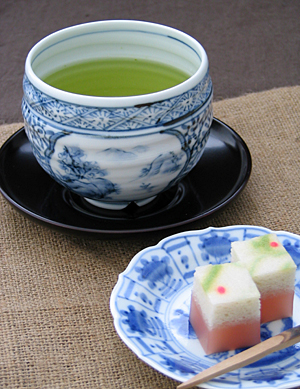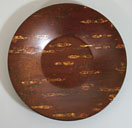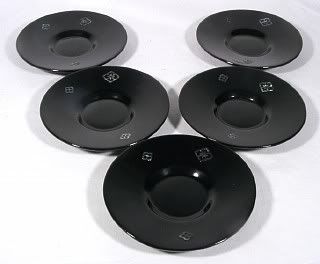The handleless Japanese teacup is called a yunomi (湯飲み), from the characters meaning "hot water" (yu) and "to drink" (nomi). This name is a holdover from the days when sencha was not freely available to ordinary people.
The chataku (茶托) is the saucer or coaster that's used underneath the yunomi. Cha means tea, of course. I'm not 100% sure exactly how taku should be translated, but it seems to mean "support". So the chataku is the item that supports the tea in its cup.
Yunomi are usually not sold with matching chataku. Therefore, you need to acquire chataku separately. (Unlike the western "teacup and saucer" set, there is no expectation that they should bear the same design.)
If you are offering sencha to a guest, it's considered more respectful to present their teacup on a yunomi. The chataku has the dual function of "coaster" and "tray". There is also the practical consideration that doing so may save your furniture from water rings!
Most day-to-day chataku are made of wood - usually fairly plain, dark wood whose appearance isn't likely to "fight" visually with the yunomi that is placed on it. (Fancier chataku are reserved for extra-special occasions.) The wood is lacquered (often to a high shine) so that the wood itself isn't damaged by moisture from the yunomi. This type of chataku is typically about 5" in diameter.
Here's a chataku with its cup sitting to the right, and an oshibori (moistened hand towel) in a basket - very cooling for summer!

Here are more examples of chataku - many of them very lovely indeed:
http://www.sikki-ya.com/page033.html
http://www.wagocoro.com/show/15000_0_0.html (towards the bottom)
Chataku for the sencha tea ceremony (Senchadou) are usually made of metal such as tin, silver or copper. They are smaller (since the cups used in sencha tea ceremony are "tasting cups" and relatively tiny), frequently oval or elongated, and may bear patterns or incised designs. Sometimes they can even be figural!
Here is an example of a chataku that can be used for Senchadou (see more on the source webpage http://www.rakuten.co.jp/oripress/434822/435256/#372740):

Chataku, as with most items involved with eating or drinking, are sold in sets of five.
Almost any yunomi looks more appealing when it has a chataku underneath it!
Here are some different chataku that I own.

The one at lower right is kabazaiku or cherry-bark; the others are made of ordinary wood, with the grain more or less prominent.
Blue-and-white (sometsuke) wares are complemented very beautifully by plain chataku:

Do you have any chataku you'd like to share?






